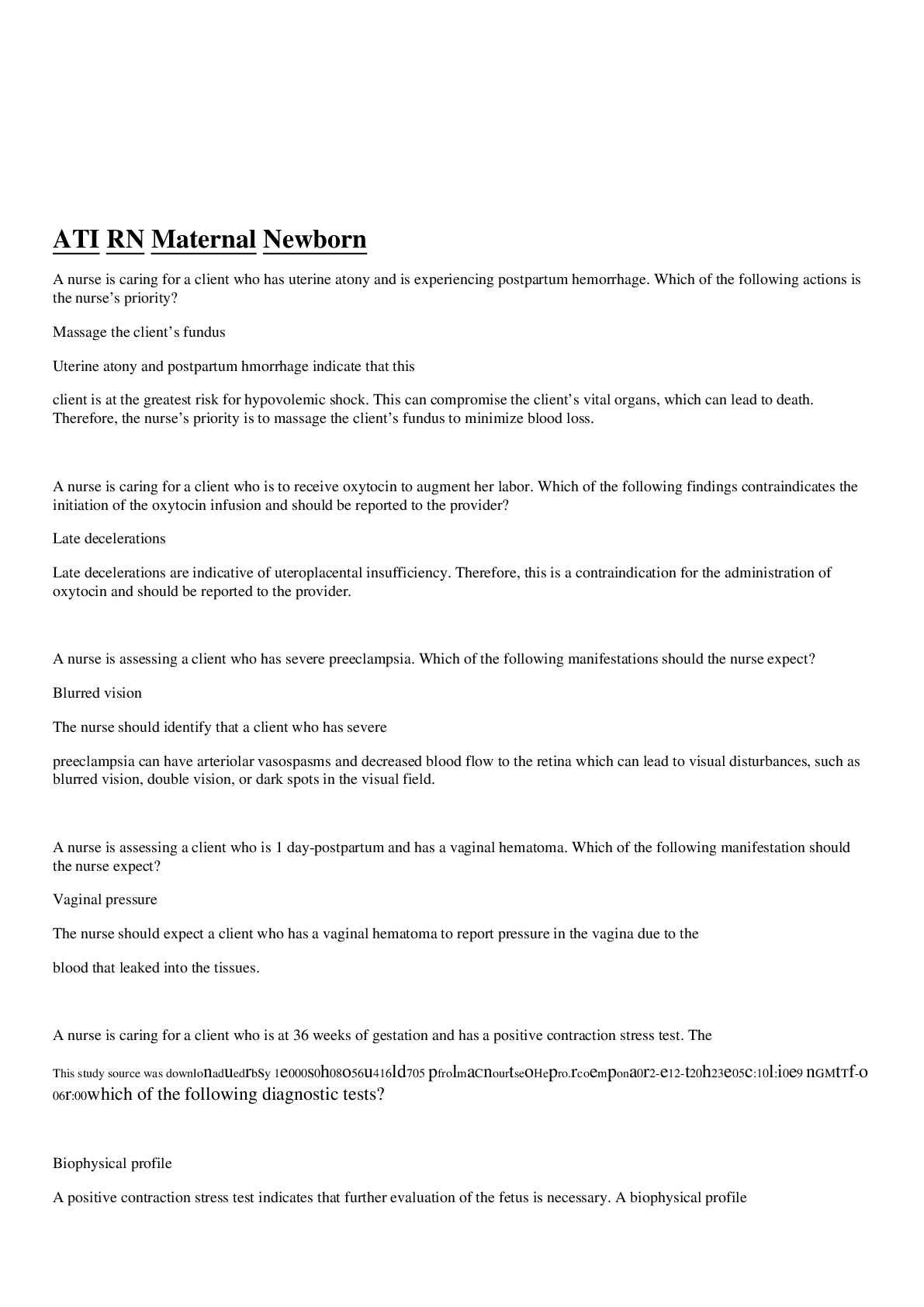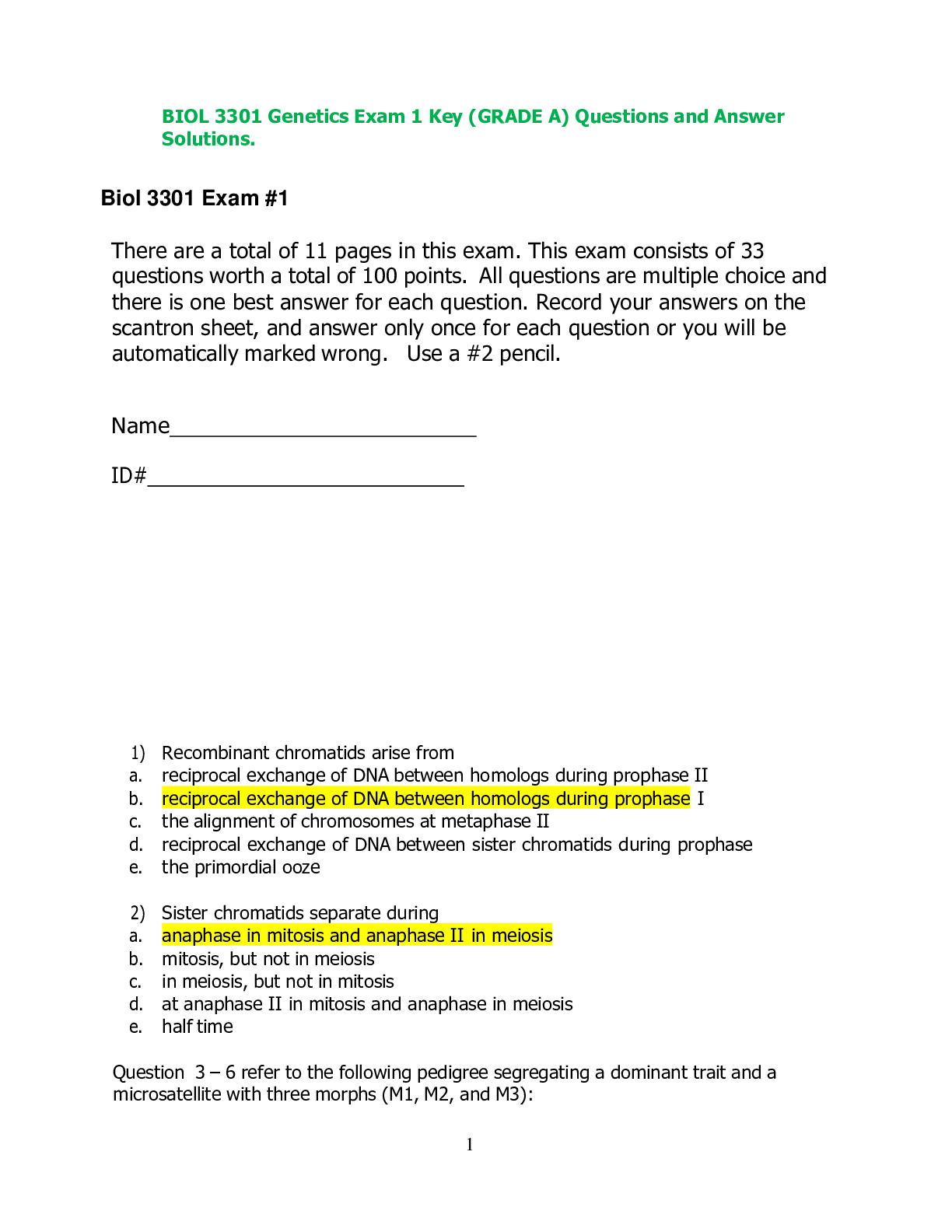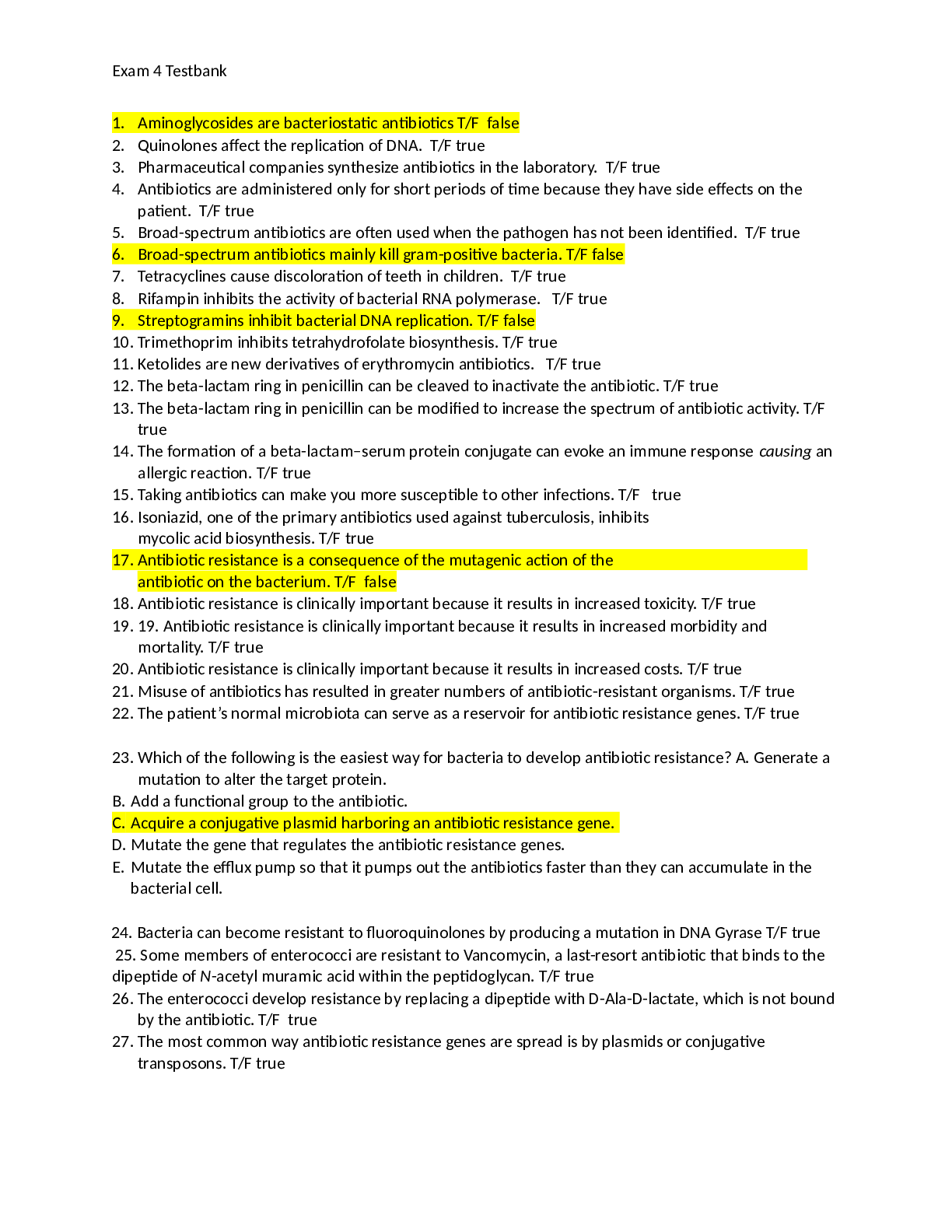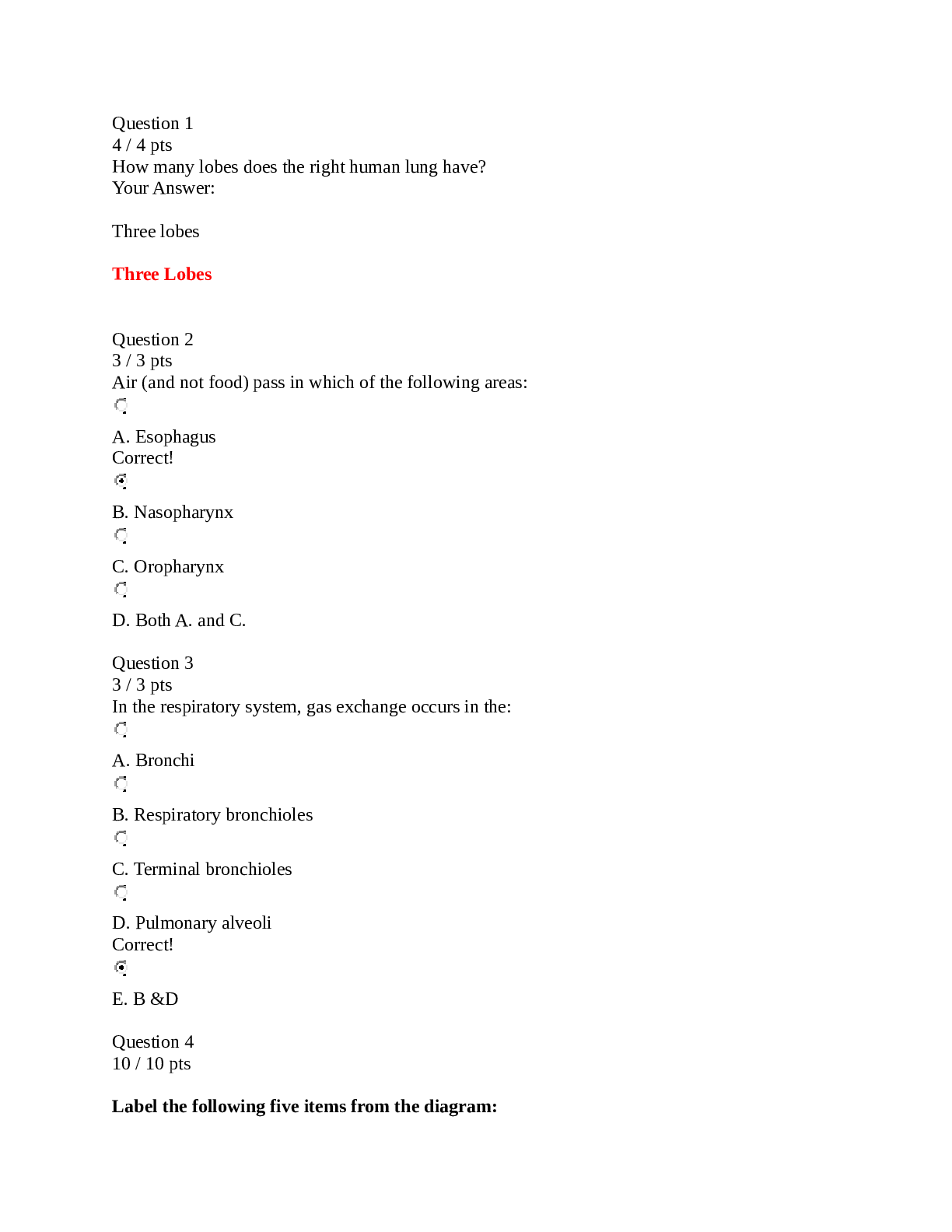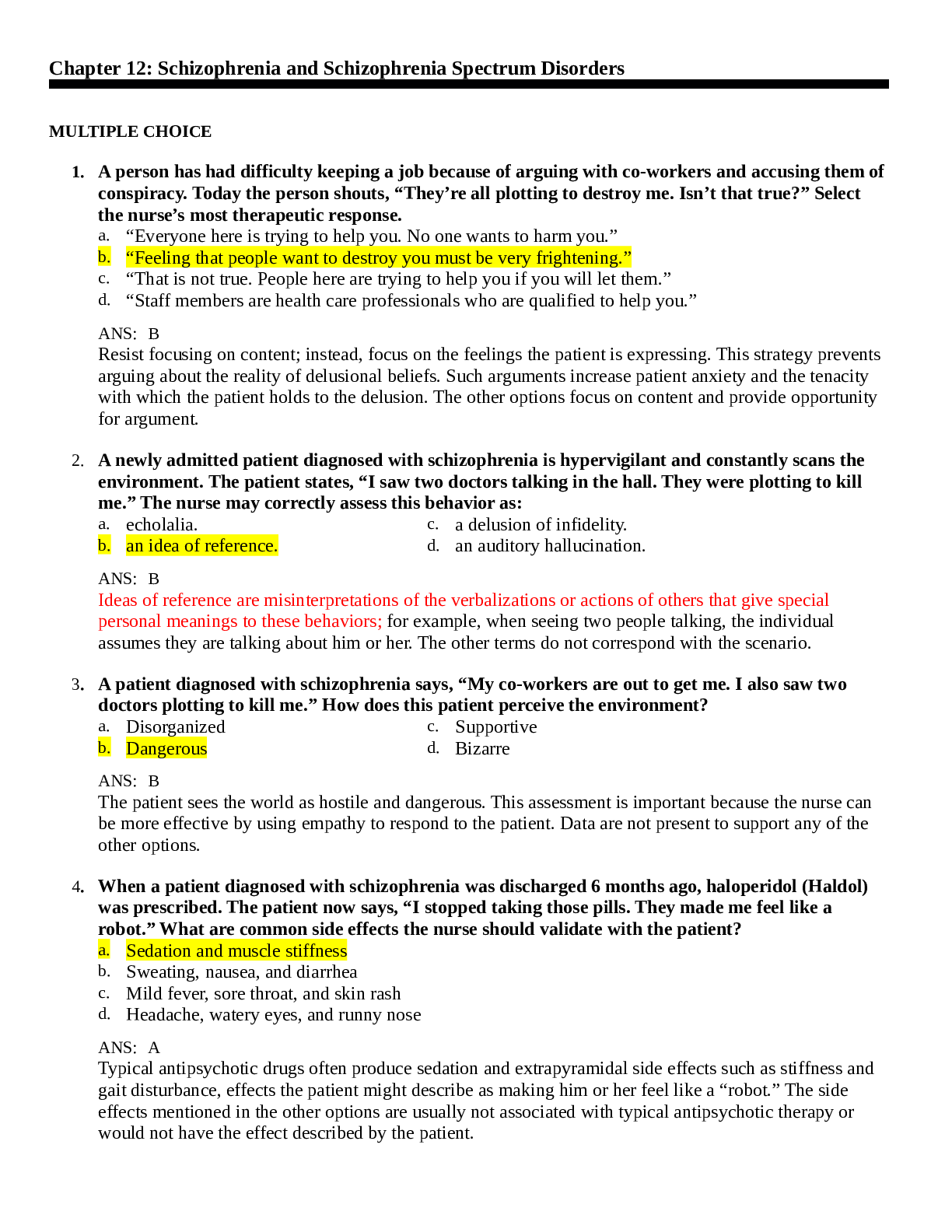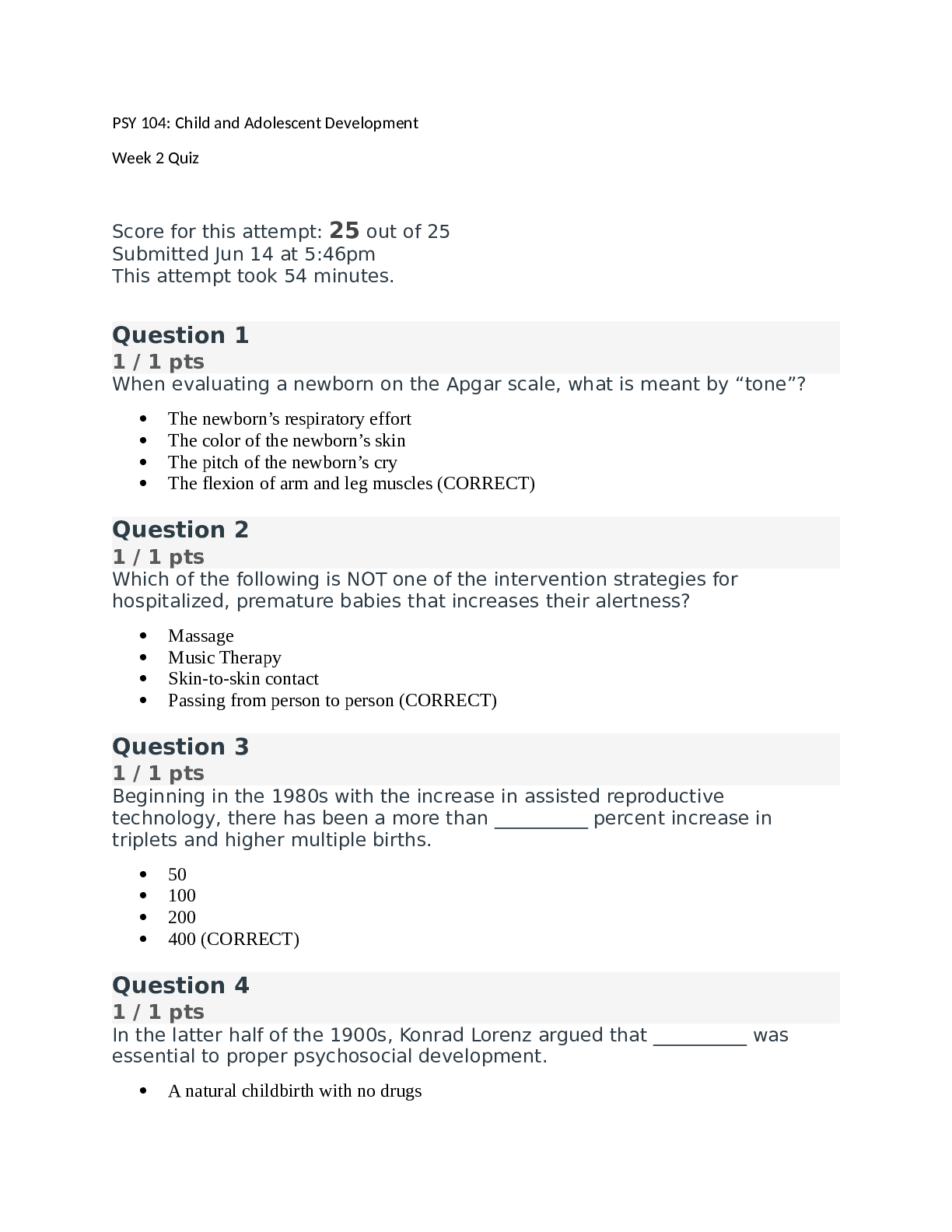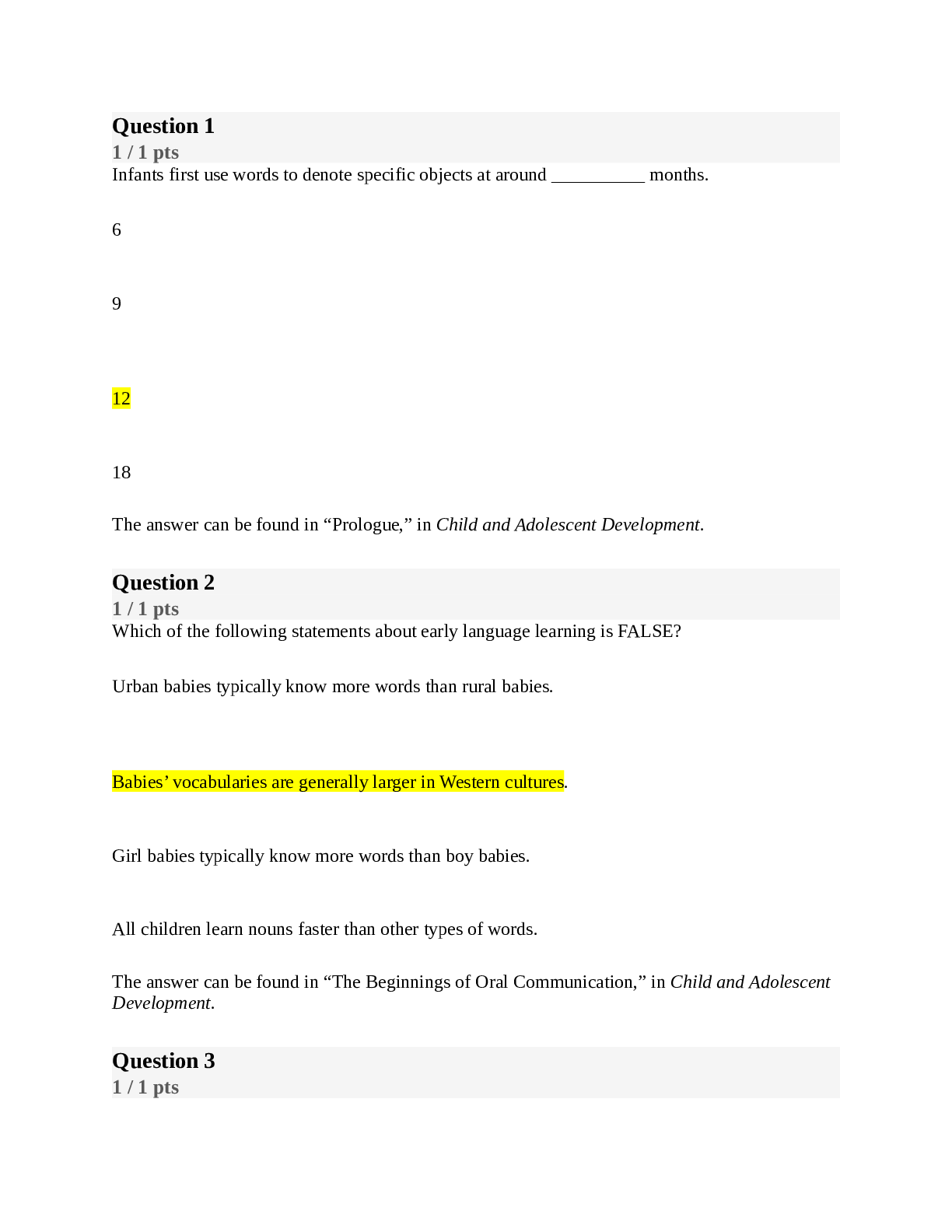Biology > EXAM > BIOD 171 ALL EXAMS (GRADED A) Questions and Answers solutions (ALL CORRECT) | 100% Guaranteed Pass (All)
BIOD 171 ALL EXAMS (GRADED A) Questions and Answers solutions (ALL CORRECT) | 100% Guaranteed Pass
Document Content and Description Below
Exam 1. True or False: A virus is considered a microorganism. False. Viruses are not living and as such are not considered microorganisms. Viruses can, however, be classified as microbes, a more... general term that includes microorganisms and viruses. 2. What is the smallest biological unit of life? A cell. 3. At a generalized level, all cells are comprised of what? Macromolecules* *A student may also answer: Proteins, Lipids, Nucleic acids and Polysaccharides but they must answer with all four to be fully correct. Exam Page 3 1. What are the two major types of nucleic acids and their roles? DNA (deoxyribonucleic acid): Contains the genetic material as well as heredity characteristics found in living organisms. RNA (ribonucleic acid): its role is for decoding the sequence of heredity information found in DNA Answer Key Exam Page 4 Answer Key Exam Page 5 Answer Key Exam Page 6 Answer Key 1. True of False: Eukaryotic cells do not have a nucleus Exam Page 7 Answer Key Exam Page 8 Answer Key Exam Page 9 Answer Key Exam Page 10 Answer Key 1. Identify the following cellular components by matching the number with the description. A. Cell wall B. Lysosome C. Centriole D. Rough endoplasmic reticulum E. Plasma membrane F. Nucleus G. Golgi apparatus 1 F 2 B EXAM MODULE 2 Answer Key Exam Page 3 Answer Key 1. Describe the energy transfer process relative to both ATP and ADP. Exam Page 4 Answer Key Exam Page 5 Answer Key Exam Page 6 Answer Key Exam Page 7 Answer Key Exam Page 8 Answer Key Exam Page 9 Answer Key Exam Page 10 Answer Key EXAM MODULE 3 Exam Page 2 Answer Key Exam Page 3 Answer Key Exam Page 4 Answer Key Exam Page 5 Answer Key A. Stage B. Fine Adjustment Knob C. Iris Diaphragm D. Neck E. Condenser Lens F. Eyepiece G. Objective H. Base I. Coaxial Controls 1F 2D Exam Page 6 Answer Key Exam Page 7 Answer Key Exam Page 8 Answer Key Exam Page 9 Answer Key Exam Page 10 Answer Key EXAM MODULE 4 Exam Page 2 Answer Key Exam Page 3 Answer Key 1. Alpha hemolysis B A. No hemolytic activity 2. Beta hemolysis C B. Incomplete hemolytic activity 3. Gamma hemolysis A C. Complete hemolytic activity Exam Page 4 Answer Key Exam Page 5 Answer Key Exam Page 6 Answer Key Exam Page 7 Answer Key Exam Page 8 Answer Key Exam Page 9 Answer Key Exam Page 10 Answer Key EXAM MODULE 5 Exam Page 2 Answer Key Exam Page 3 Answer Key Exam Page 4 Answer Key Exam Page 5 Answer Key 1. Match the following symptoms with their respective diseases: 1. Folliculitis D A. Childhood skin disease near mouth/nose 2. Scalded-skin syndrome E B. Infection of thin, transparent scleral tissue 3. Impetigo A C. Infection occurs at time of birth 4. Conjunctivitis B D. Pus-filled lesions on skin or hair 5. Ophthalmia Neonatorum C E. Ruptured pustules; treated with Penicillin Exam Page 6 Answer Key Exam Page 7 Answer Key Exam Page 8 Answer Key Exam Page 9 Answer Key Exam Page 10 Answer Key 1. Identify the following disease: A. Tetanus B. Anthrax C. Gas gangrene D. Frost bite B. Anthrax—the distinct black center at the site of infection is a hallmark of anthrax infection. 2. Gonnorrhea is caused by: A. Diplococcic bacteria B. Staphylococcus bacteria C. Gram-Negative spirochete D. RNA virus A. Diplococcic bacteria. 3. True or False. Chlamydia trachomatis can be grown on an agar plate alone. False. Chlyamdia is an obligate parasite and requires a host (viable cells) for its growth. 4. Match the following diseases with their respective symptoms if left untreated: Gonorrhea C Syphilis A Chlamydia Exam Page 2 Answer Key Exam Page 3 Attachment: The virus receptors binds to the host protein outside the cell Entry: The virus joins with the membrane of host & enters cell Uncoating: The viral capsid is pulled apart where applicable. Replication: The viral genome makes copies of itself Exit: Old virus leaves the cell & new viruses are produced New infection: New viruses produced leaves the host cell & go infect new cells. This process restarts Answer Key Exam Page 4 Answer Key Exam Page 5 Answer Key Exam Page 6 Answer Key Exam Page 7 Answer Key 1. You go to visit a friend who has chickenpox. While visiting what are 2 things you will be sure to avoid so that you don’t also become infected? (1) You would want to be sure to keep a distance especially if your friend is coughing or sneezing as chickenpox can be transmitted through air-borne droplets (sneezing/coughs). (2) You would also be absolutely certain to avoid direct contact with the blisters of an infected individual. 2. True or False. Someone who had chickenpox as a child is likely to develop shingles while in college, where the median age of college students is 18-22 years old. False. The most common age for VZV reactivation and shingle diagnosis tends to occur in people greater than 60 years of age. 3. True or False. Similar to chickenpox, the blisters that appear with Shingles can cover the entire body. False. Unlike chickenpox blisters, which can form anywhere, the blisters associated with shingles are localized and limited to small areas. 4. A person who has neither previously had chickenpox nor been administered the VZV vaccine is exposed to someone with an active VZV (shingles) outbreak and becomes infected. Explain why (or why not) the person will only develop shingles. The infected individual will not develop shingles, but will develop chickenpox. Unvaccinated and unexposed individuals must first develop chickenpox, as shingles is the reactivation of the dormant VZV virus from the chickenpox infection. Exam Page 8 Answer Key Exam Page 9 1. A drug company is trying to develop a new drug that will inhibit the release of newly produced viral particles. Would the drug company target hemagglutinin proteins or neuraminidase proteins? Why? Neuraminidase because it involves the budding & release of viral particles from the host cell 2. Explain why the flu shot given each year may not be 100% effective at preventing the flu? Because you may be exposed to a viral strain that is not included in the making of the vaccine of the flu shot that you took. Answer Key Exam Page 10 Once HIV enters the cell, the capsid is degraded, & the HIV protein reverses transcription & makes 2 RNA copies, generating DNA strand which is then transported into the nucleus where it integrates the host genome. The virus is then replicated & new viruses are formed. Anti-retroviral medication helps to fight the ability of the virus to reproduce Answer Key 1. True or False. The viral capsid of HIV is dumbbell shaped and contains ~2,000 copies of the viral protein p24. False. The HIV capsid is conical (cone) shaped. 2. The HIV surface glycoprotein gp120 binds what host cellular receptor? A. CD3 B. CXCR4 C. CCR5 D. CD4 D. HIV gp120 binds to CD4. 3. An individual infected with HIV is placed on anti-retroviral medication. Describe how the medication will affect the virus. As the name suggests, anti-retrovirals are intended to inhibit (anti) the process of reverse- transcription (retro). Once the virus enters the cell and uncoating is complete, the viral enzyme reverse transcriptase (RT) acts on the two RNA copies, creating a complementary DNA strand. Anti-retrovirals attempt to block this step. In the absence of anti-retroviral medications, the now double-stranded DNA is transported to the nucleus where it can integrate into the host genome and begin replicating. By inhibiting the process of RT, anti- retroviral medications effectively block the production of new viruses by preventing its integration and replication. [Show More]
Last updated: 1 year ago
Preview 1 out of 34 pages
Instant download

Buy this document to get the full access instantly
Instant Download Access after purchase
Add to cartInstant download
Reviews( 0 )
Document information
Connected school, study & course
About the document
Uploaded On
May 17, 2022
Number of pages
34
Written in
Additional information
This document has been written for:
Uploaded
May 17, 2022
Downloads
0
Views
25






.png)






